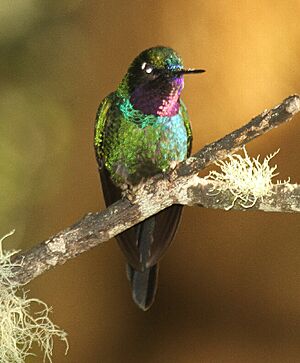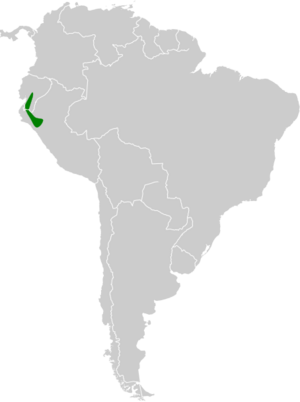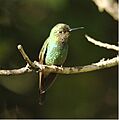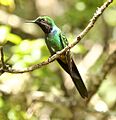Purple-throated sunangel facts for kids
Quick facts for kids Purple-throated sunangel |
|
|---|---|
 |
|
| Conservation status | |
| Scientific classification | |
| Genus: |
Heliangelus
|
| Species: |
viola
|
 |
|
The purple-throated sunangel (Heliangelus viola) is a beautiful little hummingbird. It belongs to a group of hummingbirds called "coquettes." You can find this bird living in the Andes mountains of Ecuador and Peru. It's known for its bright colors, especially the male's shiny throat.
Contents
About Its Name
Scientists like to group animals to understand them better. This is called Taxonomy. Most scientists agree that the purple-throated sunangel is just one type of bird. However, some groups, like the Clements taxonomy, think there are three slightly different kinds, or "subspecies."
What Does It Look Like?
The purple-throated sunangel is a small bird. It is about 11 to 12 centimeters (4 to 5 inches) long. It weighs around 5 to 7 grams, which is about the same as a few paper clips! It has a short, straight, black beak.
Both male and female sunangels have shiny green feathers on their backs. Their bellies are also green. The feathers in the middle of their tail are bright green, while the others are blackish.
Adult males have a special blue-green patch above their beak. They also have a deep purple, shiny throat patch called a gorget. Below this, there's a blue-green bar on their chest.
Female sunangels look a bit different. They do not have the blue-green patch above their beak or the shiny purple throat. Instead, their throat is a light brown or off-white color with some bronzy green spots. Young sunangels look similar to the adult females.
Where Does It Live?
The purple-throated sunangel lives on the western side of the Andes mountains. You can find it from north-central Ecuador all the way south into Peru. It lives in places like the departments of Cajamarca and Amazonas.
This bird likes many different types of places. It lives inside and on the edges of cloudforests. It also likes secondary forests, which are forests that have grown back after being cut down. You can also find it in alder woodlands and bushy areas. It lives at high elevations, usually between 2,150 and 3,000 meters (about 7,000 to 9,800 feet) above sea level.
How Does It Behave?
Movement
The purple-throated sunangel is a "sedentary" bird. This means it usually stays in one area and does not migrate or move around much.
Feeding
This hummingbird eats two main things: nectar from flowers and small insects. In some parts of Ecuador, it seems to rely on a tree called Eucalyptus globulus for food. It catches insects by flying out from a perch, which is called "hawking." It also picks insects off plants, which is called "gleaning."
Reproduction
The purple-throated sunangel's breeding season is from October to January. The female bird lays two white eggs. She is the one who sits on the eggs to keep them warm until they hatch. Scientists do not know much more about how these birds raise their young.
Vocalization
The purple-throated sunangel makes several different sounds. Its calls include a loose series of short, dry trills. It also makes a repeated, long, dry, buzzing sound.
Status
The IUCN (International Union for Conservation of Nature) has looked at the purple-throated sunangel. They have assessed it as being of "Least Concern." This means that it is not currently considered to be in danger of disappearing.
Even though we do not know the exact number of these birds, scientists believe their population is stable. It lives in a somewhat small area, but it is quite common in many places within that area. The good news is that it also lives in several protected natural areas.
Images for kids





